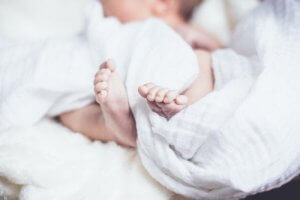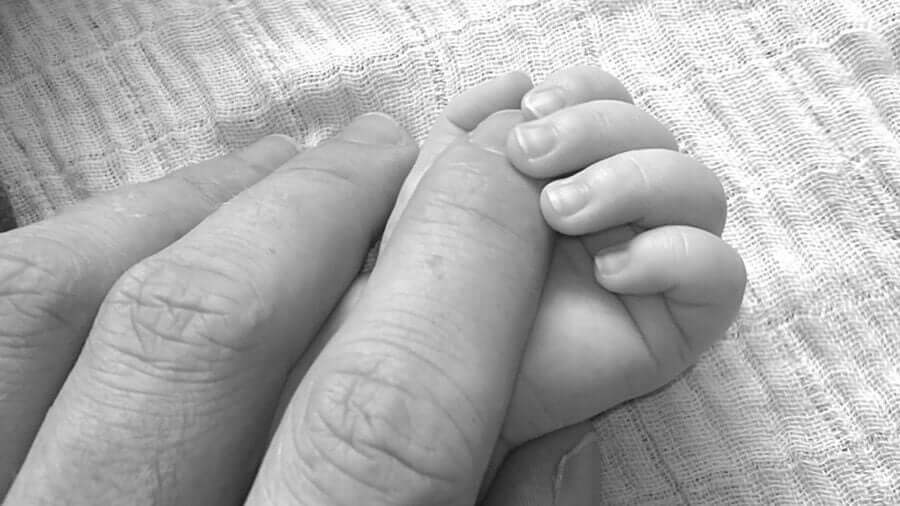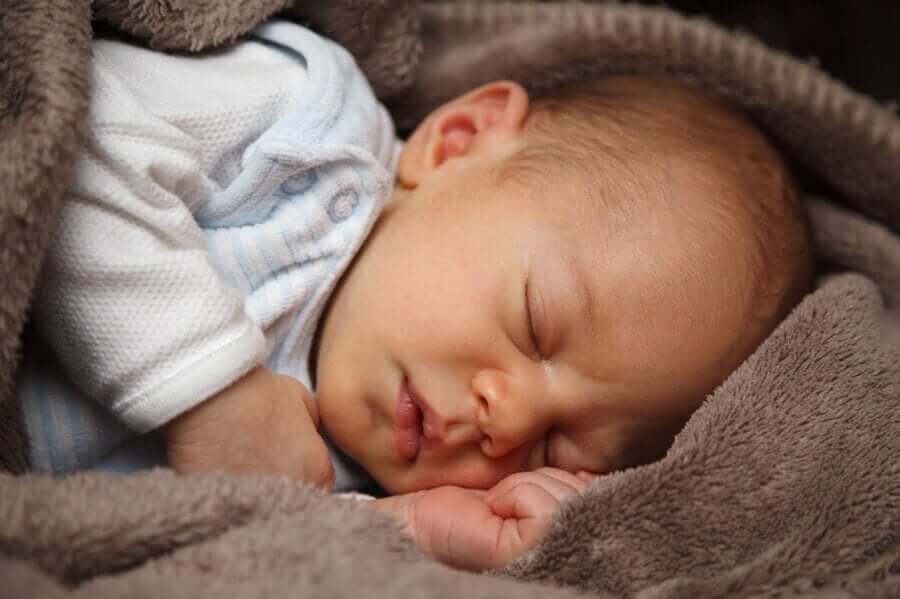Sleeping Patterns in One-Year-Old Babies

Since birth, babies usually stick close by their mother. Commonly, they sleep in the same bed as their parents, or close by. When the time comes for them to sleep alone, we’ll show you some routines for children who are one year old. That way, they’ll develop good sleeping patterns and will be able to relax.
Children’s sleep patterns after they’re one year old
Newborns sleep practically all the time, except when they eat. When babies are one, they’re normally awake 12 hours and sleep 12 hours. Usually, they need help from their parents to calm down and fall asleep until they can regulate their own schedule.

Why doesn’t my child want to sleep?
There are several reasons why children might have sleep disorders starting at one year old. One of the main causes is anxiety about leaving the bed or their parents’ room. This bothers some children, causing them to be afraid and have nightmares.
Other possible causes:
- Discomfort from teething interfere with normal sleeping patterns
- They feel too hot or cold
- Brightly colored rooms don’t help them calm down to fall asleep
Childhood sleeping patterns
Usually, kids need between 10 and 13 hours of sleep. Still, there are children who sleep well at night and don’t need to sleep during the day. Others sleep a little during the day and go back to sleep at night. Additionally, other babies don’t nap well because it makes it hard for them to sleep at night.
As kids grow, they’ll sleep through the night. However, they might have some periods of waking up or needing naps.
“Babies’ sleep at one year old is similar to how adults sleep: 75% deep sleep and 25% light sleep.”
Factors that influence children’s sleeping patterns
Babies won’t automatically be able to regulate their own sleeping patterns. In fact, it may take months or years to adapt. In any case, it’s important to teach your baby good sleeping habits. Some of the common causes of restlessness at night are:
- The child’s temperament and curiosity
- Poor diet
- Bad sleeping habits in the first few months of life
- Diseases
Routines to promote sleep in one-year-old babies
Many children resist sleeping, and many parents give up immediately trying to make them sleep. Keep in mind that it’s a period of negative transition for your baby. Therefore, be patient and take note of some effective and simple strategies that you can try:
- Give your baby a warm bath
- Set the same bedtime every night
- Read a fun story or play a quiet game
- Get rid of loud noises or lights in the room
- Have his favorite blanket or toy handy so he doesn’t feel lonely
You must figure out how much time your child needs to sleep. In addition, you need to distribute those hours between nighttime and naps.

What not to do at bedtime
It’s important to eliminate any element or activity that might distract your baby and make it hard to fall asleep.
- Don’t place large stuffed animals or lots of pillows with your baby. Then, he might use it to jump out of his crib. Also, don’t put his crib by curtains or windows.
- Don’t let him take long naps.
- Just before bedtime, don’t let your child play rough games that rile him up.
- Don’t make long visits to his room to reassure him. All it will do is keep your baby awake.
You can regulate your baby’s sleep patterns if you see their needs from their point of view. It’s a matter of replacing bad behaviors with good sleep habits. The important thing is that your baby sleeps well and doesn’t get cranky during the day.
Since birth, babies usually stick close by their mother. Commonly, they sleep in the same bed as their parents, or close by. When the time comes for them to sleep alone, we’ll show you some routines for children who are one year old. That way, they’ll develop good sleeping patterns and will be able to relax.
Children’s sleep patterns after they’re one year old
Newborns sleep practically all the time, except when they eat. When babies are one, they’re normally awake 12 hours and sleep 12 hours. Usually, they need help from their parents to calm down and fall asleep until they can regulate their own schedule.

Why doesn’t my child want to sleep?
There are several reasons why children might have sleep disorders starting at one year old. One of the main causes is anxiety about leaving the bed or their parents’ room. This bothers some children, causing them to be afraid and have nightmares.
Other possible causes:
- Discomfort from teething interfere with normal sleeping patterns
- They feel too hot or cold
- Brightly colored rooms don’t help them calm down to fall asleep
Childhood sleeping patterns
Usually, kids need between 10 and 13 hours of sleep. Still, there are children who sleep well at night and don’t need to sleep during the day. Others sleep a little during the day and go back to sleep at night. Additionally, other babies don’t nap well because it makes it hard for them to sleep at night.
As kids grow, they’ll sleep through the night. However, they might have some periods of waking up or needing naps.
“Babies’ sleep at one year old is similar to how adults sleep: 75% deep sleep and 25% light sleep.”
Factors that influence children’s sleeping patterns
Babies won’t automatically be able to regulate their own sleeping patterns. In fact, it may take months or years to adapt. In any case, it’s important to teach your baby good sleeping habits. Some of the common causes of restlessness at night are:
- The child’s temperament and curiosity
- Poor diet
- Bad sleeping habits in the first few months of life
- Diseases
Routines to promote sleep in one-year-old babies
Many children resist sleeping, and many parents give up immediately trying to make them sleep. Keep in mind that it’s a period of negative transition for your baby. Therefore, be patient and take note of some effective and simple strategies that you can try:
- Give your baby a warm bath
- Set the same bedtime every night
- Read a fun story or play a quiet game
- Get rid of loud noises or lights in the room
- Have his favorite blanket or toy handy so he doesn’t feel lonely
You must figure out how much time your child needs to sleep. In addition, you need to distribute those hours between nighttime and naps.

What not to do at bedtime
It’s important to eliminate any element or activity that might distract your baby and make it hard to fall asleep.
- Don’t place large stuffed animals or lots of pillows with your baby. Then, he might use it to jump out of his crib. Also, don’t put his crib by curtains or windows.
- Don’t let him take long naps.
- Just before bedtime, don’t let your child play rough games that rile him up.
- Don’t make long visits to his room to reassure him. All it will do is keep your baby awake.
You can regulate your baby’s sleep patterns if you see their needs from their point of view. It’s a matter of replacing bad behaviors with good sleep habits. The important thing is that your baby sleeps well and doesn’t get cranky during the day.
All cited sources were thoroughly reviewed by our team to ensure their quality, reliability, currency, and validity. The bibliography of this article was considered reliable and of academic or scientific accuracy.
- Espinar Sierra, J., & Ramos Platón, M. J. (1992). Trastornos del sueño en niños. Revista de La Asociación Española de Neuropsiquiatría.
- Suárez, A., & Robles, B. (2005). Hábitos de sueño en la revisión del niño sano. Bol Pediatr.
- Del Valle, M. O. (2012). El sueño en la edad preescolar y su repercusión en el desarrollo, la conducta y el aprendizaje. Revista Cubana de Higiene y Epidemiología.
- Estivill, E., & Segarra, F. (2000). Insomnio infantil por hábitos incorrectos. Rev Neurol, 30(2), 188-91. http://amapamu.org/actividades/charlas2006/segarra.pdf
- Montserrat Gala, A. M., & Fortes del Valle, M. A. (2013). Aprender a dormir. Pediatría Atención Primaria, 15(60), e145-e155. http://amapamu.org/actividades/charlas2006/segarra.pdf
- Del Riesgo, A. B., & Velez, I. V. (1991). Errores en la crianza de los niños (Vol. 5). BEF, Biblioteca Ecuatoriana de la Familia.
- Cabano, S. (2014). El sueño infantil y el apego. https://www.colibri.udelar.edu.uy/jspui/bitstream/20.500.12008/4398/1/Santiago%20Cabano.TFG.2014.pdf
- Arboledas, G. P., Salort, M. M., & Marabotto, L. M. Higiene del sueño y melatonina. http://cursosaepap.exlibrisediciones.com/files/49-201-fichero/Higiene%20del%20sueño.pdf
This text is provided for informational purposes only and does not replace consultation with a professional. If in doubt, consult your specialist.








